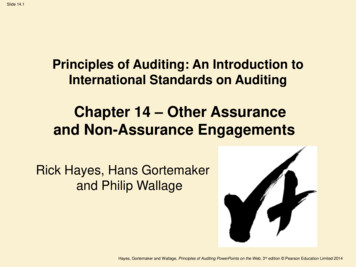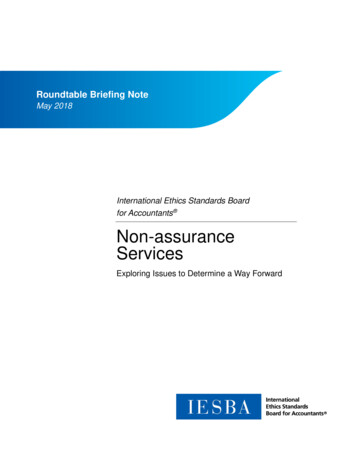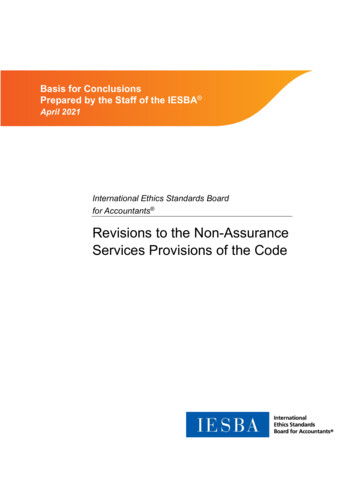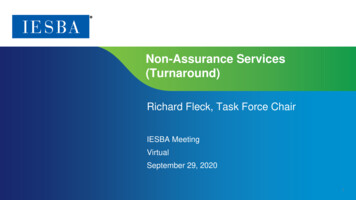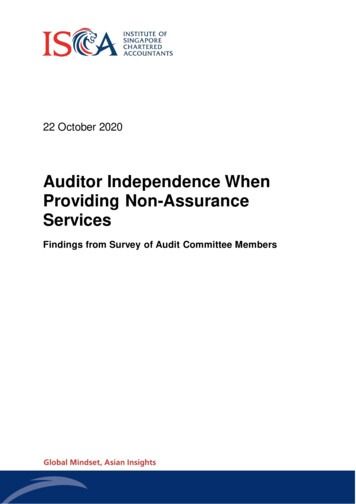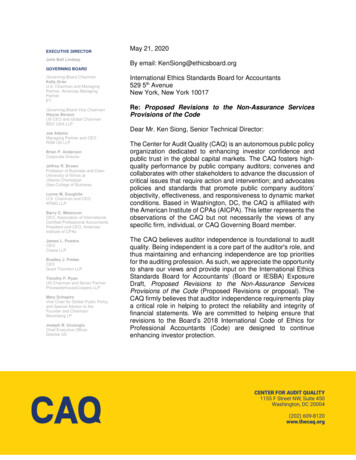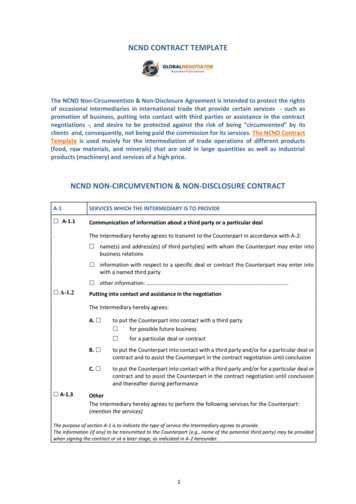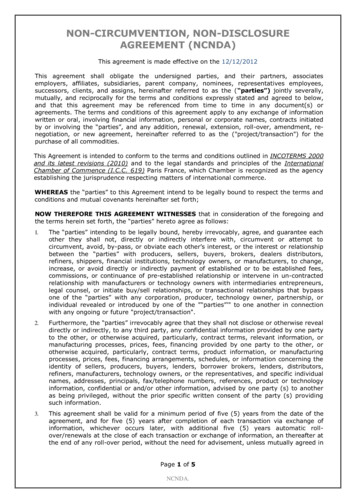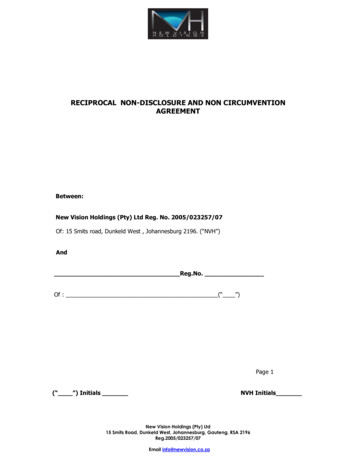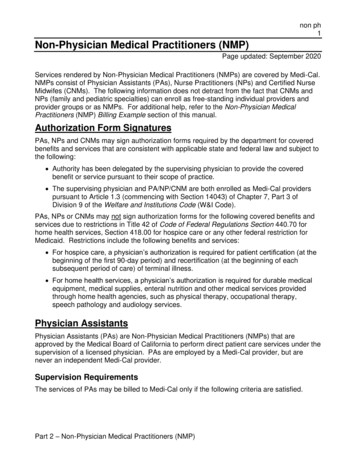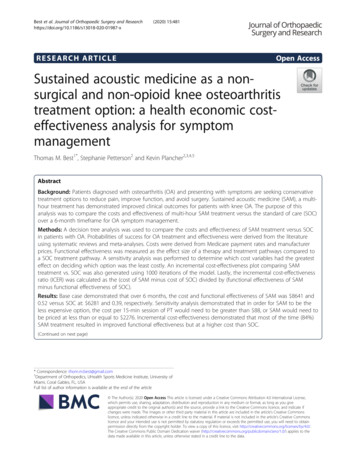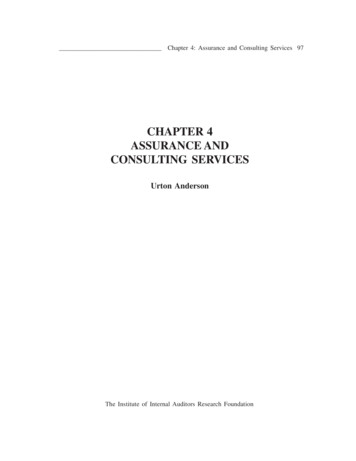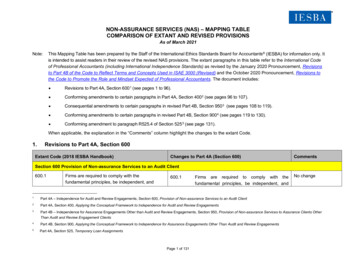
Transcription
NON-ASSURANCE SERVICES (NAS) – MAPPING TABLECOMPARISON OF EXTANT AND REVISED PROVISIONSAs of March 2021Note:This Mapping Table has been prepared by the Staff of the International Ethics Standards Board for Accountants (IESBA) for information only. Itis intended to assist readers in their review of the revised NAS provisions. The extant paragraphs in this table refer to the International Codeof Professional Accountants (including International Independence Standards) as revised by the January 2020 Pronouncement, Revisionsto Part 4B of the Code to Reflect Terms and Concepts Used in ISAE 3000 (Revised) and the October 2020 Pronouncement, Revisions tothe Code to Promote the Role and Mindset Expected of Professional Accountants. The document includes: Revisions to Part 4A, Section 600 1 (see pages 1 to 96). Conforming amendments to certain paragraphs in Part 4A, Section 400 2 (see pages 96 to 107). Consequential amendments to certain paragraphs in revised Part 4B, Section 950 3 (see pages 108 to 119). Conforming amendments to certain paragraphs in revised Part 4B, Section 900 4 (see pages 119 to 130). Conforming amendment to paragraph R525.4 of Section 525 5 (see page 131).When applicable, the explanation in the “Comments” column highlight the changes to the extant Code.1.Revisions to Part 4A, Section 600Extant Code (2018 IESBA Handbook)Changes to Part 4A (Section 600)CommentsSection 600 Provision of Non-assurance Services to an Audit Client600.1Firms are required to comply with thefundamental principles, be independent, and600.1Firms are required to comply with thefundamental principles, be independent, andNo change1Part 4A – Independence for Audit and Review Engagements, Section 600, Provision of Non-assurance Services to an Audit Client2Part 4A, Section 400, Applying the Conceptual Framework to Independence for Audit and Review Engagements3Part 4B – Independence for Assurance Engagements Other than Audit and Review Engagements, Section 950, Provision of Non-assurance Services to Assurance Clients OtherThan Audit and Review Engagement Clients4Part 4B, Section 900, Applying the Conceptual Framework to Independence for Assurance Engagements Other Than Audit and Review Engagements5Part 4A, Section 525, Temporary Loan AssignmentsPage 1 of 131
NON-ASSURANCE SERVICES – MAPPING TABLECOMPARISION OF EXTANT AND REVISED PROVISIONSPrepared by the Staff of IESBAAs of March 2021Extant Code (2018 IESBA Handbook)Changes to Part 4A (Section 600)apply the conceptual framework set out in Section120 to identify, evaluate and address threats toindependence.Commentsapply the conceptual framework set out inSection 120 to identify, evaluate and addressthreats to independence.600.2Firms and network firms might provide a range ofnon-assurance services to their audit clients,consistent with their skills and expertise.Providing non-assurance services to audit clientsmight create threats to compliance with thefundamental principles and threats toindependence.600.2Firms and network firms might provide a range ofnon-assurance services to their audit clients,consistent with their skills and expertise. Providingnon-assurance services to audit clients might createthreats to compliance with the fundamentalprinciples and threats to independence.600.3This section sets out requirements andapplication material relevant to applying theconceptual framework to identify, evaluate andaddress threats to independence when providingnon-assurance services to audit clients. Thesubsections that follow set out specificrequirements and application material relevantwhen a firm or network firm provides certain nonassurance services to audit clients and indicatethe types of threats that might be created as aresult. Some of the subsections includerequirements that expressly prohibit a firm ornetwork firm from providing certain services to anaudit client in certain circumstances because thethreats created cannot be addressed by applyingsafeguards.600.3This section sets out requirements andapplication material relevant to applying theconceptual framework to identify, evaluate andaddress threats to independence whenproviding non-assurance services to auditclients. The subsections that follow set outspecific requirements and application materialthat are relevant when a firm or a network firmprovides certain types of non-assuranceservices to audit clients and indicate the typesof threats that might be created as a result.600.4Some subsections include requirements thatexpressly prohibit a firm or a network firm fromproviding certain services to an audit clientbecause the threats created cannot beeliminated and safeguards are not capable ofPage 2 of 131No changeSlight refinements to:(i) acknowledge newrequirements,including theintroduction of selfreview prohibition ingeneral provisions;and (ii) emphasizethat the conceptualframework and thegeneral provisions ofSection 600 applywhen specificrequirements andapplication materialare not included.
NON-ASSURANCE SERVICES – MAPPING TABLECOMPARISION OF EXTANT AND REVISED PROVISIONSPrepared by the Staff of IESBAAs of March 2021Extant Code (2018 IESBA Handbook)Changes to Part 4A (Section 600)Commentsbeing applied to reduce the threats to anacceptable level.R600.4Before a firm or a network firm accepts anengagement to provide a non-assurance serviceto an audit client, the firm shall determine whetherproviding such a service might create a threat toindependence.R600.8Before a firm or a network firm accepts anengagement to provide a non-assuranceservice to an audit client, the firm shall apply theconceptual framework to identify, evaluate andaddress any threat to independence that mightbe created by providing that service.Refinements to clarifyfirm responsibilitybefore undertakingNAS600.4 A1The requirements and application material in thissection assist the firm in analyzing certain typesof non-assurance services and the related threatsthat might be created if a firm or network firmprovides non-assurance services to an auditclient.600.3This section sets out requirements andapplication material relevant to applying theconceptual framework to identify, evaluate andaddress threats to independence whenproviding non-assurance services to auditclients. The subsections that follow set outspecific requirements and application materialthat are relevant when a firm or a network firmprovides certain types of non-assuranceservices to audit clients and indicate the typesof threats that might be created as a result.When providing a non-assurance service forwhich there are no specific requirements andapplication material in the Code, the conceptualframework and the general provisions in thissection apply.Repositioned asintroductory materialPage 3 of 131
NON-ASSURANCE SERVICES – MAPPING TABLECOMPARISION OF EXTANT AND REVISED PROVISIONSPrepared by the Staff of IESBAAs of March 2021Extant Code (2018 IESBA Handbook)Changes to Part 4A (Section 600)Comments600.4 A2New business practices, the evolution of financialmarkets and changes in information technology,are among the developments that make itimpossible to draw up an all-inclusive list of nonassurance services that might be provided to anaudit client. As a result, the Code does not includean exhaustive list of all non-assurance servicesthat might be provided to an audit client.600.5New business practices, the evolution offinancial markets and changes in technologyare some developments that make it impossibleto draw up an all-inclusive list of non-assuranceservices that firms and network firms mightprovide to an audit client. The conceptualframework and the general provisions in thissection apply when a firm proposes to a clientto provide a non-assurance service for whichthere are no specific requirements andapplication material.Refinements to: (i)drop the word“information” from“informationtechnology”; (ii)replaced last sentencein extant with areference to theapplication of theconceptual framework.n/an/a600.6 A1Paragraphs R100.6 to 100.7 A1 set outrequirements and application material relatingto compliance with the Code. If there are lawsand regulations in a jurisdiction relating to theprovision of non-assurance services to auditclients that differ from or go beyond those setout in this section, firms providing nonassurance services to which such provisionsapply need to be aware of those differences andcomply with the more stringent provisions.New applicationmaterialn/an/a600.9 A1A description of the categories of threats thatmight arise when a firm or a network firmprovides a non-assurance service to an auditclient is set out in paragraph 120.6 A3.New applicationmaterialPage 4 of 131
NON-ASSURANCE SERVICES – MAPPING TABLECOMPARISION OF EXTANT AND REVISED PROVISIONSPrepared by the Staff of IESBAAs of March 2021Extant Code (2018 IESBA Handbook)Changes to Part 4A (Section 600)Comments600.5 A1600.9 A2 Lead in nowemphasizes thefactors are alsorelevant inidentifying thedifferent threats Factors in 2nd andlast bullet are new Factors reorderedFactors that are relevant in evaluating the level ofthreats created by providing a non-assuranceservice to an audit client include: The nature, scope and purpose of theservice. The degree of reliance that will be placed onthe outcome of the service as part of theaudit. The legal and regulatory environment inwhich the service is provided. Whether the outcome of the service willaffect matters reflected in the financialstatements on which the firm will express anopinion, and, if so: oThe extent to which the outcome ofthe service will have a material effecton the financial statements.oThe degree of subjectivity involved indetermining the appropriate amountsor treatment for those mattersreflected in the financial statements.The level of expertise of the client’smanagement and employees with respect tothe type of service provided.Page 5 of 131Factors that are relevant in identifying thedifferent threats that might be created byproviding a non-assurance service to an auditclient, and evaluating the level of such threatsinclude: The nature, scope, intended use andpurpose of the service. The manner in which the service will beprovided, such as the personnel to beinvolved and their location. The legal and regulatory environment inwhich the service is provided. Whether the client is a public interestentity. The level of expertise of the client’smanagement and employees with respectto the type of service provided. The extent to which the client determinessignificant matters of judgment. (Ref: Para.R400.13 to R400.14). Whether the outcome of the service willaffect the accounting records or mattersreflected in the financial statements on
NON-ASSURANCE SERVICES – MAPPING TABLECOMPARISION OF EXTANT AND REVISED PROVISIONSPrepared by the Staff of IESBAAs of March 2021Extant Code (2018 IESBA Handbook)Changes to Part 4A (Section 600) The extent of the client’s involvement indetermining significant matters of judgment. The nature and extent of the impact of theservice, if any, on the systems that generateinformation that forms a significant part ofthe client’s: oAccounting records or financialstatements on which the firm willexpress an opinion.oInternal controlsreporting.overCommentswhich the firm will express an opinion, and,if so:financial Whether the client is a public interest entity.For example, providing a non-assuranceservice to an audit client that is a publicinterest entity might be perceived to result ina higher level of a threat.Page 6 of 131oThe extent to which the outcome ofthe service will have a material effecton the financial statements.oThe degree of subjectivity involvedin determining the appropriateamounts or treatment for thosematters reflected in the financialstatements.The nature and extent of the impact of theservice, if any, on the systems thatgenerate information that forms asignificant part of the client’s:oAccounting records or financialstatements on which the firm willexpress an opinion.oInternal controlsreporting.overfinancial The degree of reliance that will be placedon the outcome of the service as part of theaudit. The fee relating to the provision of the nonassurance service.
NON-ASSURANCE SERVICES – MAPPING TABLECOMPARISION OF EXTANT AND REVISED PROVISIONSPrepared by the Staff of IESBAAs of March 2021Extant Code (2018 IESBA Handbook)Changes to Part 4A (Section 600)Comments600.5 A2Subsections 601 to 610 include examples ofadditional factors that are relevant in evaluating thelevel of threats created by providing the nonassurance services set out in those subsections.600.9 A3 n/an/a600.11 A1 Providing advice and recommendations mightcreate a self-review threat. Whether providingadvice and recommendations creates a selfreview threat involves making the determinationset out in paragraph R600.14. Where the auditclient is not a public interest entity and a selfreview threat is identified, the firm is required toapply the conceptual framework to evaluate andaddress the threat. If the audit client is a publicinterest entity, paragraphs R600.16 andR600.17 apply.New applicationmaterial600.5 A3Subsections 601 to 610 refer to materiality inrelation to an audit client’s financial statements.The concept of materiality in relation to an audit isaddressed in ISA 320, Materiality in Planning andPerforming an Audit, and in relation to a review inISRE 2400 (Revised), Engagements to ReviewHistorical Financial Statements. The determinationof materiality involves the exercise of professionaljudgment and is impacted by both quantitative and600.10 A1 Materiality is a factor that is relevant inevaluating threats created by providing a nonassurance service to an audit client.Subsections 601 to 610 refer to materiality inrelation to an audit client’s financial statements.The concept of materiality in relation to an auditis addressed in ISA 320, Materiality in Planningand Performing an Audit, and in relation to areview in ISRE 2400 (Revised), Engagementsto Review Historical Finan
non-assurance services to audit clients. The subsections that follow set out specific requirements and application material relevant when a firm or network firm provides certain non-assurance services to audit clients and indicate the types of threats that might be
